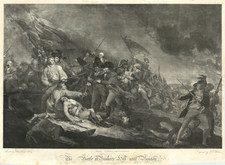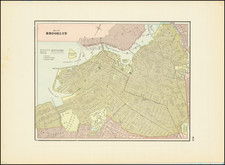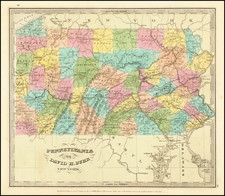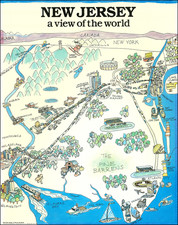One of a Few Surviving Manuscript Maps Made For The Continental Army To Remain in Private Hands
Large manuscript map of northern New Jersey and southern New York (including New York City), “the cockpit of the American Revolution”, drawn by John Erskine for use in the field by Major General Nathanael Greene, during the Continental Army's defense of West Point in the summer of 1779.
The map is executed in iron gall ink and grey wash and dissected in sixteen parts, mounted on original linen. Perhaps hastily completed, the map has a distinctly Continental Army aesthetic -- it lacks the decorative cartouches and studied hand of a British soldier-mapmaker; instead, it is simple, utilitarian, and effective.
As the map declares in its title, it is drawn “from the Origional [sic] of Rt. Erskine F.R.S.” That original map was a pivotal piece of cartography in its own right; it was drawn by Robert Erskine for George Washington in 1777, and it so impressed Washington that he made Robert Erskine Geographer and Surveyor General of the Continental Army immediately after receiving it. Washington's copy of the Robert Erskine map is now in the collection of the Morgan Library in New York.
The map was drawn on May 28th, 1779, by John Erskine, who at the time was serving as one a small group of express riders working under Nathaniel Greene. John Erskine made several changes to Washington's Robert Erskine map which go to the heart of why it was prepared for Nathanael Greene in May of 1779. First, he improved the northern half of the map, adding additional toponyms (specifically those of forges) and modifying the road network. Second, in the middle of the map, he added “Middlebrook” (initially having incorrectly located Boundbrook there). Middlebrook was at that moment the location of the winter encampment of the Continental Army and was where the map was drawn. All of this was because the Continental Army would soon be marching north, out of Middlebrook, on a major defensive operation.
Nathanael Greene and the Continental Army's Defense of West Point in the Summer of 1779
When the Revolutionary War began, Nathanael Greene was a private in the militia, but he would emerge from the war as George Washington's most gifted and dependable officer, celebrated as one of the war's three most important generals. At the time of the creation of the map, Nathanael Greene was second in command of the Continental Army, serving directly under George Washington. His rise to second in command and the construction of this map are integrally linked.
Washington expressed concern to the Continental Congress and his senior officers that the Continental army’s supply lines and resources were being poorly mismanaged at Valley Forge in 1778. Washington placed his trust in the abilities of Greene to effectively correct the problem. Greene was appointed Quartermaster General in March, 1778, at which time he reorganized the supply system for the entire army. At one point, during Washington’s absence to meet with French forces, Greene was the commander of the entire continental army, and successfully defeated British forces in parts of New Jersey during this time. He went on to take command of West Point until the arrival of Washington in 1780 and was then selected as the Commander of the Southern Continental Army on October 14, 1780, replacing General Horatio Gates.
In the spring of 1779, Washington and Greene were engaged in preparations for the summer campaign against the British when the first intelligence reports began arriving regarding a British offensive up the Hudson River, in order to take West Point. Washington had long feared a British offensive which would take West Point, splitting the American forces and isolating New England.
As demonstrated by the time line below, John Erskine's preparation of the map (dated May 28, 1779) corresponds with the Continental Army's defense of West Point in June 1779 and the establishment of Washington's headquarters at West Point in the Summer of 1779. The map was prepared just two days before the start of the Continental Army's march from its winter quarters in Middlebrook, New Jersey (shown on the map) to West Point.
- On May 21, Washington received the first intelligence from Elijah Hunter that the British were planning an expedition up the Hudson towards King's Ferry and West Point.
- On May 28, British General Henry Clinton led a British force up the Hudson River toward West Point.
- On May 28, Colonel Alexander Hamilton, Washington's aide-de-camp, informed General Arthur St. Clair that, "recent intelligence indicates the probability of the enemy being on the front of some important movement [so] get your division ready to march as soon as possible."
- On May 28, John Erskine completed this map "for the use of" Nathanael Greene, whose job as Quartermaster it was to organize supplies for the Continental Army on its march northward.
- On May 29, Colonel Israel Shreve provided additional intelligence that a large British naval force was preparing for immediate action.
- On May 29, Washington received further intelligence of six British regiments moving north from through Westchester County with plans to sail up the Hudson.
- On May 30, New York Governor George Clinton ordered the militia into the field to defend against the British assault.
- On June 1, the British seized Stony Point and Verplanck's Point.
- On June 1, Washington ordered the Continental Army to march to the head of the Highlands to counter the British offensive.
Advancing with the Army, Greene was the primary logistical planner for the march, a massive undertaking for the time. By June 7, 1779, the Army had traversed approximately 100 miles north, across the northern half of the present map, arriving at Smith's Clove, fourteen miles west of West Point. Upon its arrival, Greene set about rounding up supplies, living in a leaky tent, as there was a shortage of houses available. Schelhammer describes the Continental Army's movement as "one of their longest and most rapid marches of the war up to that point" and noted that Washington described the major repositioning of his army to maintain control of the Hudson as "a very interesting crisis."
John Erskine
Very little is known about John Erskine. His rank is given as captain. At the time the map was created, he was serving as an express rider in the employ of the Quartermaster General, one of 24 riders then employed by the Continental Army.
The creation of the map on May 28, 1779 was likely a catalyst for Erkine's appointment as superintendent of 24 express riders under General Nathanael Greene. A letter from Nathanael Greene to Charles Pettit on June 9, 1779, "appoint[ing] Capt. Erskine captain to the expresses, as the former captain had allowed intolerable negligence to prevail," was written several days after Greene completed the transit northward in defense of West Point with Washington (written from Smith's Clove, New York).
A brief discussion of Erskine's role as superintendent of the express riders appear in the Proceedings of the New Jersey Historical Society, Volume 6; Volume 39 at p. 175-176 and "The Continental Express Rider," Daughters of the American Revolution Magazine, Volume 57 at p. 656-57.
Robert Erskine and his map
Born in Scotland, Erskine attended the University of Edinburgh. He became known as an inventor and engineer of some renown. In 1771, at the age of 36, he was elected a Fellow of the Royal Society, during which time he also became a land surveyor.
In 1771, William Alexander (Lord Stirling), Surveyor General of New Jersey and owner of an ironworks near Ringwood, New Jersey, hired Erskine to run the ironworks. At the outset of the Revolutionary War, Erskine organized the first militia in northern New Jersey and was appointed as a militia captain in August 1775. An early American concern was that the British warships would go up the Hudson River to attack northern forts and separate New England from the rest of the colonies. To address the threat, Erskine designed a tetrahedron-shaped marine cheval-de-frise, a defensive barrier to prevent warships from sailing upriver. It was installed between the northern end of Manhattan and Fort Lee, New Jersey in 1776.
In March 1777, Lord Stirling recommended to General Nathanael Greene that Erskine be hired to serve as Chief Engineer of the Continental Army, a position which Erskine declined, stating that he was unqualified for the position, "but that branch [of service], to which practical geometry and mechanics is necessary, I could undertake with some Confidence. . . " Tholl, p. 3.
Erskine's mapmaking skills came to the attention of George Washington in 1776. At the time, Washington was bemoaning the lack of useful maps available to him for military planning. On January 26, 1777, George Washington wrote from Morristown, New Jersey, to John Hancock, the President of the Continental Congress:
The want of accurate Maps of the Country which has hitherto been the Scene of War, has been of great disadvantage to me. I have in vain endeavored to procure them and have been obliged to make shift, with such sketches as I could trace from my own Observations, and that of Gentlemen around me.
Two persons are now employed in making me a draft of this part of the Country andI really think, if Gentlemen of known Character & probity could be employed in making Maps (from actual Survey) of the Roads—The Rivers and Bridges and Fords over them—the Mountains and passes thro’ them, it would be of the greatest Advantage.(Strike over is original to Washington's letter)
Robert Erskine’s role as mapmaker for the Continental Army apparently began in December 1776, when he made a sketch of the New Jersey countryside for Major General Charles Lee. In the spring of 1777, Erskine made for George Washington a map of New Jersey and southern New York that could be folded and carried in his pocket, entitled A Map of Part of the States of New-York and New-Jersey: Laid Down, Chiefly from Actual Surveys, Received from the Right Honble Ld Stirling & Others, and Deliniated for the Use of His Excely Genl Washington, by Robt Erskine F.R.S. 1777. This map, based on contemporary maps and surveys supplied by Lord Stirling, contains sixteen annotations by George Washington. The map survives, badly tattered and stained from use, in the collection of the Pierpont Morgan Library in New York City and is reproduced in Martin, Washington Atlas, plate 14.
Impressed by Robert Erskine's work, Washington met with him in July, 1777 and recommended to the Congress that he be hired. Erskine's commission as Geographer and Surveyor General was approved by Congress on July 27, 1777, and Washington wrote Erskine the following day that, "your entrance upon the business will be immediately necessary." In November 1777, Washington formally asked Erskine when he could start his work, with Erskine replying that he could begin in April 1778, as he was actively engaged in other projects, including making maps from Governor Clinton of New York and running the ironworks in Ringwood.
In February and March 1779, Washington wrote Erskine, urging him to move his mapping headquarters from Ringwood, New Jersey to a place better protected from enemy searchers, resulting in Erskine's relocation to New Windsor, New Jersey.
Rarity
Manuscript maps from the Revolutionary War are exceptionally rare on the market, but still rarer are hand-drawn maps made specifically for officers in the Continental Army. Indeed, we cannot trace a single map made for a Continental Army General appearing on the market in many decades. Two small American sketch maps related to the Penobscot Expedition were sold at Northeast Auction in 2013, and a year before that a small map of the Battle of Monmouth was also sold at Northeast. None of these maps were obviously drawn for a Continental Army officer, as is the case with the present map.
Provenance: Christie’s New York, October 2019. Acquired by the previous owner in 1959.









![[Battle of Lexington] Journee de Lexington . . .](https://storage.googleapis.com/raremaps/img/small/94722.jpg)




![[Lake Champlain] Map of the County of Clinton By David H. Burr](https://storage.googleapis.com/raremaps/img/small/80723.jpg)